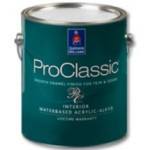
Sherwin-Williams has won an EPA green chemistry award for paints made from recycled soda bottles, among other materials.
The company won the Designing Greener Chemicals category at the border:none windowtext 1.0pt;mso-border-alt:none windowtext 0in; padding:0in”>Presidential Green Chemistry Challenge Awards for water-based acrylic alkyd paints that can be made from recycled PET plastic, acrylics, and soybean oil. Unlike traditional alkyd (oil-based) paints, the Sherwin-Williams alkyd has low levels of volatile organic compounds, the EPA said. But the paint still offers the performance benefits of alkyds, the agency said.
In 2010, Sherwin-Williams manufactured enough of these new paints to eliminate over 800,000 pounds of VOCs. The paints are sold as ProClassic Waterbased Acrylic Alkyd, ProMar 200 Waterbased Acrylic Alkyd, and ProIndustrial Waterborne Enamel.
In other categories, Genomatica won a Greener Synthetic Pathways award for developing a microbe that uses sugar fermentation to make 1,4-Butanediol (BDO), a high-volume chemical building block used to make many common polymers, such as spandex. When produced at commercial scale, Genomatica’s Bio-BDO will be less expensive, require about 60 percent less energy, and produce 70 percent less carbon dioxide emissions than BDO made from natural gas, the EPA says. Genomatica is partnering with major companies to bring Bio-BDO to the market.
The Greener Reaction Conditions award went to Kraton Performance Polymers for its reverse osmosis membranes for salt water purification. The Nexar family of halogen-free, high-flow, polymer membranes are made using less solvent, allowing them to purify hundreds of times more water than traditional membranes, saving 70 percent in membrane costs and 50 percent on energy costs, the EPA says.
The Small Business award went to BioAmber for the integrated production and downstream applications of biobased succinic acid, and the Academic Award went to Bruce Lipshutz from the University of California, Santa Barbara, for work to reduce the chemical manufacturing industry’s dependence on organic solvents and therefore minimize waste.
You can listen to podcasts about this year’s winners here.
In related news, a Pike Research study out yesterdayprojected that the green chemistry market will grow from $2.8 billion in 2011 to $98.5 billion by 2020.
Despite this dramatic growth, Pike said that this emerging market represent “a drop in the bucket” compared to the $4 trillion global chemical industry. By 2020, Pike expects that the total chemical industry will expand to $5.3 trillion in annual revenues.
“Green chemistry markets are currently nascent, with many technologies still at laboratory or pilot scale,” says Pike Research president Clint Wheelock, “and many production-scale green chemical plants are not expected to be running at capacity for several more years.
“However, most green chemical companies are targeting large, existing chemical markets, so adoption of these products is limited less by market development issues than by the ability to feed extant markets at required levels of cost and performance.”
Pike Research forecasts that the biggest penetration for green chemistry will be in the polymer sector (5.7 percent), as it is somewhat more developed than the other key sectors. The special, fine, and commodity chemical sectors are more nascent.
Pike identified three major themes driving the green chemistry movement:
Waste minimization in the chemical production process;
Replacement of existing products with less toxic alternatives; and
A shift to renewable (non-petroleum) feedstocks.
Article courtesy of environmentalleader.com

